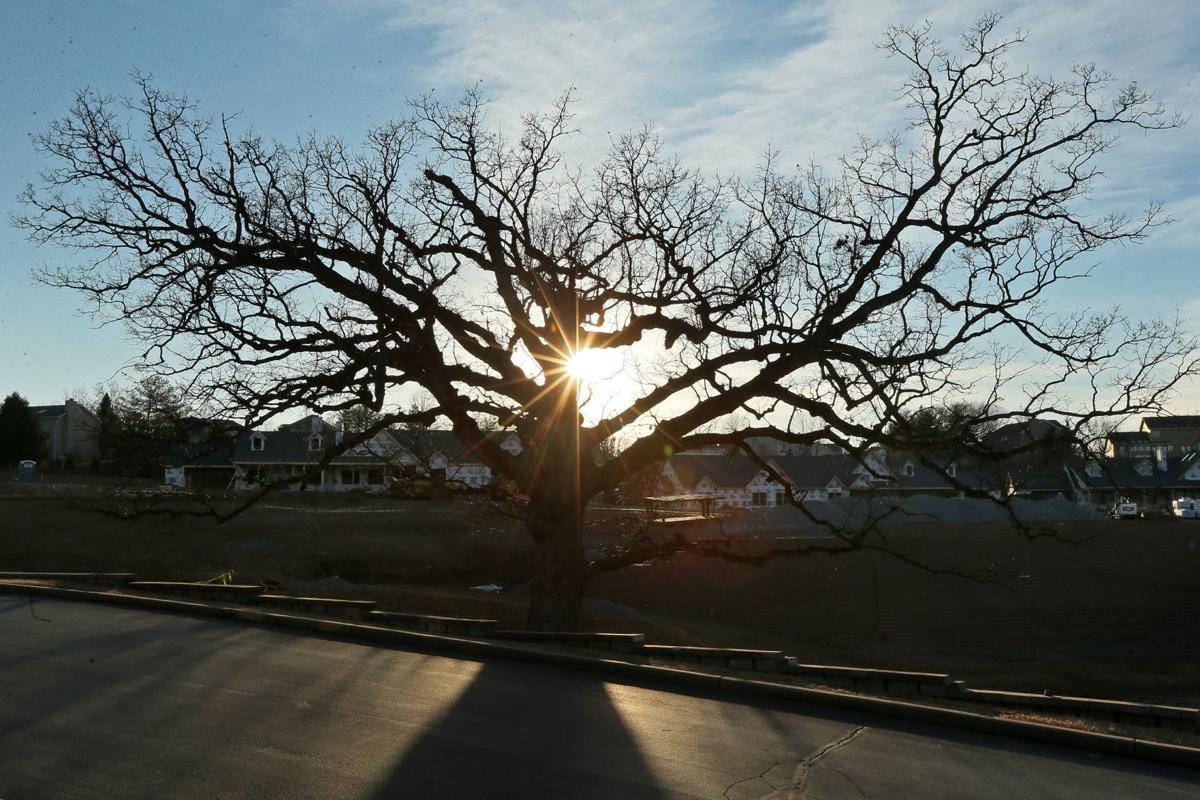ST. LOUIS COUNTY • Every second around the world the reach of progress grasps a little more farmland here, a piece of forest there, to meet the demands of the masses.
Things such as lawns, paved roads and bourbon barrels.
A giant white oak tree on a sliver of unincorporated St. Louis County near Creve Coeur has somehow avoided all of this, and meanwhile helped lend truth to Crested View Drive, Quiet Lane and other street names that tout a country lifestyle amid urban sprawl.
The tree, which has survived countless storms, is easily 150 to 200 years old, experts say.
A thick lightning seam follows the rugged bark to the ground, where the beginnings of a vast root system bubble up as big as chairs to sit on.
Some say it looks like a haunted house tree. The head has been lopped off. There’s deadwood and cavities amid the maze of thick, sturdy branches that grow outward, supported by a tall trunk.
Measuring 16 feet around, it’s way too big to hug, but a bookkeeper at a nearby nursing home recently had something else in mind.
“I was going to wrap myself around it,” said Dee Hughes, of Rosewood Care Center, 11278 Schuetz Road. “I look at it every day. I was so glad they left it.”
The tree stands between her building and a $15 million development shooting up on the other side.
Tim Dolan, of Dolan Memory Care Homes, said he didn’t have the heart to knock the tree down with the rest of a wooded hillside where he is building a center and eight group homes for people with Alzheimer’s disease and dementia.
The 11-acre area has been uninhabitable for most modern humans. A 24-foot-tall by 600-foot-long block retaining wall and 22,000 cubic yards of fill material are changing that.
The first home in the new development, called Waterford Crossing, is supposed to open this spring.
“We are in the long-term care business,” said Dolan, 68. “We like old people. We like older things. We thought, ‘We gotta save this tree.’”
Oddly, several residents in the area haven’t noticed the tree. It’s because the tree used to be in a small forest that was home to deer, raccoons, coyotes, foxes and red-tailed hawks.
“One tree,” said Joan Sowers, who moved there to raise a family in 1972. “That was big of him. Wow. Generous.”
She remembered what it used to look like when a farmer had a log cabin and even drank well water into the 1980s. After he died, the woods remained as a buffer from development.
“It’s sad because people like to see nature and trees and bushes and not building after building after building,” she said. “You are taking away some of the reason for living in the county — the beauty and the nature.”
Dr. Sam Page, who represents the 2nd District on the County Council, said his region had a good balance of natural habitat and development.
“We know that in this area, especially in the Creve Coeur area, there is a high demand for housing for folks who need memory care solutions,” he said. “We need a place to take care of them.”
He said the main remnant of the former woods was a good one.
“It’s obvious that they went to great pains to keep that tree,” he said. “It’s really going to stand out the way it is presented.”
The original development plan was changed to include the tree, which meant reconfiguring the retention wall and sewer lines. Cary Semsar, an arborist at Meyer Tree Service, was called in to work up protection guidelines before construction started.
But first he was in awe.
“It’s certainly a tree worth saving,” Semsar said. “You don’t have those kinds of old trees around very often.”
He said the giant white oak was a survivor from a different ecosystem. Trees like this in urban conditions normally max out at 3 feet in diameter. This one is 5 feet in diameter.
Semsar said old trees had more aesthetic value and biodiversity than young trees. Pockets of rot and decay bring more fungi and bugs, which feed birds and other animals.
While root systems typically extend three times the height of the tree, he cautioned builders in this case to stay clear of the drip line from the outer branches.
Tree experts estimated a healthy white oak could live about 300 years, but no one is sure how long this one will last.
Dolan, the developer, said they cordoned off the area and kept heavy machinery away from it.
“We don’t know if its going to live or not,” he said. “We have our fingers crossed.”
He wishes the tree could talk, to share its own stories.









